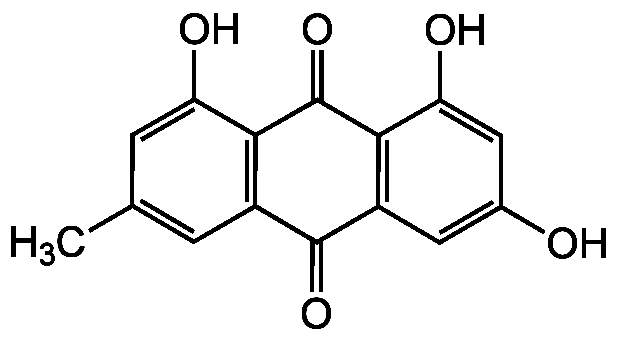
Chemical Structure
Emodin [518-82-1]

AG-CN2-0457
Overview
- SupplierAdipoGen Life Sciences
- Product NameEmodin [518-82-1]
- Delivery Days Customer10
- CAS Number518-82-1
- CertificationResearch Use Only
- Estimated Purity>98%
- Hazard InformationWarning
- Molecular FormulaC15H10O5
- Molecular Weight270.2
- Scientific DescriptionChemical. CAS: 518-82-1. Formula: C15H10O5. MW: 270.2. Isolated from Polygonum cuspidatum. p56lck protein kinase inhibitor. Competitive casein kinase II (CK2) inhibitor. Anticancer agent with apoptosis inducing with antiangiogenic activity. Antioxidant, vasorelaxant and neuroprotective agent. NF-kappaB activation inhibitor. Inflammasome inhibitor. Potent selective 11beta-HSD1 inhibitor. Improves insulin sensitivity and lipid metabolism. Estrogen receptor ERalpha and ERbeta inhibitor. Inhibits androgen receptor (AR) nuclear translocation and induces AR degradation. VEGFR2, FGFR-1, EGFR, PDGFR-beta and Kit inhibitor. JAK2 inhibitor. Anti-diabetic agent. AMPK activator and PPARgamma agonist. Adipogenesis inhibitor. P2X7 receptor antagonist. Wnt signaling & PI3K/Akt/GSK-3beta pathway modulator. - p56lck protein kinase inhibitor. Competitive casein kinase II (CK2) inhibitor. Anticancer agent with apoptosis inducing with antiangiogenic activity. Antioxidant, vasorelaxant and neuroprotective agent. NF-kappaB activation inhibitor. Inflammasome inhibitor. Potent selective 11beta-HSD1 inhibitor. Improves insulin sensitivity and lipid metabolism. Estrogen receptor ERalpha and ERbeta inhibitor. Inhibits androgen receptor (AR) nuclear translocation and induces AR degradation. VEGFR2, FGFR-1, EGFR, PDGFR-beta and Kit inhibitor. JAK2 inhibitor. Anti-diabetic agent. AMPK activator and PPARgamma agonist. Adipogenesis inhibitor. P2X7 receptor antagonist. Wnt signaling & PI3K/Akt/GSK-3beta pathway modulator.
- SMILESCC1=CC2=C(C(O)=C1)C(=O)C1=C(C=C(O)C=C1O)C2=O
- Storage Instruction2°C to 8°C,RT
- UNSPSC12352200
References
- Vasorelaxant effect of emodin, an anthraquinone from a Chinese herb: H.C. Huang, et al.; Eur. J. Pharmacol. 205, 289 (1991)
- Emodin, a protein tyrosine kinase inhibitor from Polygonum cuspidatum: H. Jayasuriya, et al.; J. Nat. Prod. 55, 696 (1992)
- Emodin (3-methyl-1,6,8-trihydroxyanthraquinone) inhibits TNF-induced NF-kappaB activation, IkappaB degradation, and expression of cell surface adhesion proteins in human vascular endothelial cells: A. Kumar, et al.; Oncogene 17, 913 (1998)
- Emodin, an anthraquinone derivative isolated from the rhizomes of Rheum palmatum, selectively inhibits the activity of casein kinase II as a competitive inhibitor: H. Yim, et al.; Planta Med. 65, 9 (1999)
- Phytoestrogens from the roots of Polygonum cuspidatum (Polygonaceae): structure-requirement of hydroxyanthraquinones for estrogenic activity: H. Matsuda, et al.; Bioorg. Med. Chem. Lett. 11, 1839 (2001)
- Emodin induces apoptosis of human cervical cancer cells through poly(ADP-ribose) polymerase cleavage and activation of caspase-9: G. Srinivas, et al.; Eur. J. Pharmacol. 473, 117 (2003)
- Emodin down-regulates androgen receptor and inhibits prostate cancer cell growth: T.L. Cha, et al.; Cancer Res. 65, 2287 (2005)
- Emodin inhibits vascular endothelial growth factor-A-induced angiogenesis by blocking receptor-2 (KDR/Flk-1) phosphorylation: H.J. Kwak, et al.; Int. J. Cancer 118, 2711 (2006)
- Emodin has a cytotoxic activity against human multiple myeloma as a Janus-activated kinase 2 inhibitor: A. Muto, et al.; Mol. Cancer Ther. 6, 987 (2007)
- Screening of Kit inhibitors: suppression of Kit signaling and melanogenesis by emodin: S.J. Lee, et al.; Phytother. Res. 24, 308 (2010)
